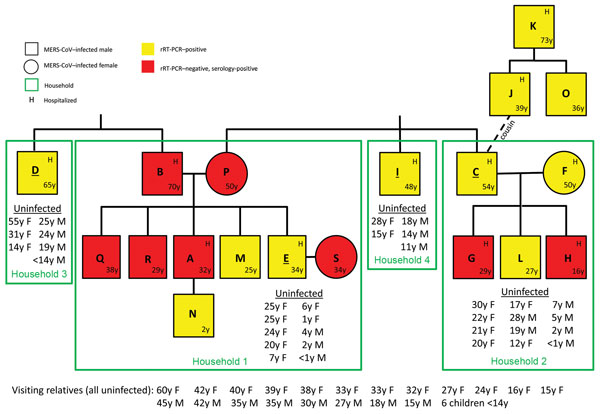Middle East Respiratory Syndrome Coronavirus Transmission in Extended Family, Saudi Arabia, 2014
M. Allison Arwady, Basem M. Alraddadi, Colin Basler, Esam I. Azhar, Eltayb Abuelzein, Abdulfattah I. Sindy, Bakr M. Bin Sadiq, Abdulhakeem O. Althaqafi, Omaima Shabouni, Ayman Banjar, Lia M. Haynes, Susan I. Gerber, Daniel R. Feikin, and Tariq A. Madani

Author affiliations: Centers for Disease Control and Prevention, Atlanta, Georgia, USA (M.A. Arwady, C. Basler, L.M. Haynes, S.I. Gerber, D.R. Feikin); King Faisal Specialist Hospital and Research Center, Jeddah (B. Alraddadi); Ministry of Health, Jeddah, Saudi Arabia (B. Alraddadi, E.I. Azhar, E. Abuelzein, A.I. Sindy, B.M. Bin Sadiq, A.O. Althaqafi, O. Shabouni, A. Banjar, T.A. Madani); King Abdulaziz University, Jeddah (E.I. Azhar, T.A. Madani); Ministry of National Guard, Jeddah (A.O. Althaqafi)
Main Article
Figure 1

Figure 1. Family relationships and household distribution of persons infected with MERS-CoV, Al-Qouz, Saudi Arabia, 2014. Black lines denote standard family tree relationships. Patients are lettered in order of symptom onset or, if asymptomatic, by test date. Green boxes indicate households; all persons living in households 1–4 were tested, except for 2 adults living in household 4 (not shown). Index patient (person with earliest symptom onset diagnosed by rRT-PCR) in each household is underlined. Uninfected indicates person in household with negative rRT-PCR results and (if >14 years of age) negative serologic testing for MERS-CoV. Visiting relatives indicates extended family members who regularly visited the 4 households and were present in the households on the day of the field investigation. MERS-CoV, Middle East respiratory syndrome coronavirus; rRT-PCR, real-time reverse transcription PCR.
Main Article
Page created: July 15, 2016
Page updated: July 15, 2016
Page reviewed: July 15, 2016
The conclusions, findings, and opinions expressed by authors contributing to this journal do not necessarily reflect the official position of the U.S. Department of Health and Human Services, the Public Health Service, the Centers for Disease Control and Prevention, or the authors' affiliated institutions. Use of trade names is for identification only and does not imply endorsement by any of the groups named above.
